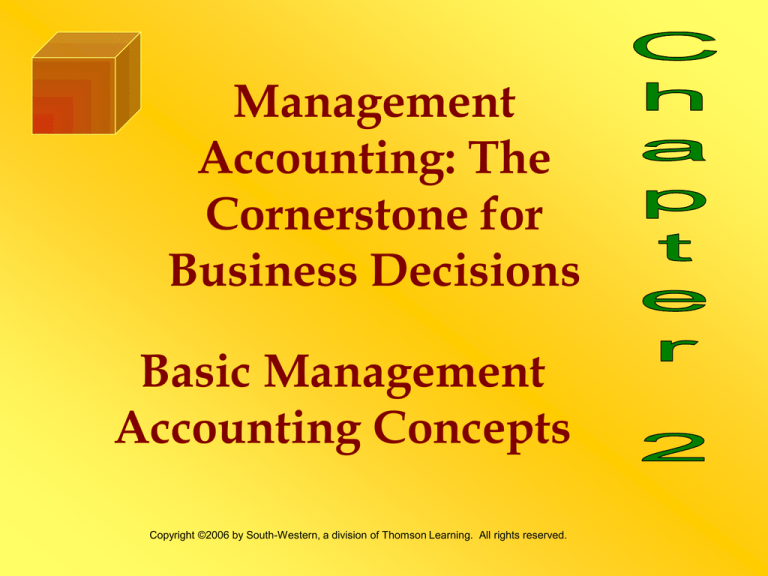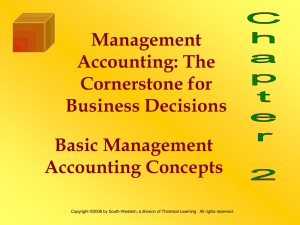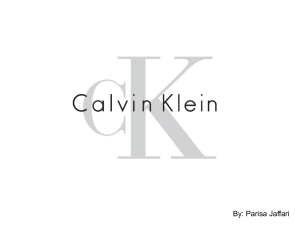
Management
Accounting: The
Cornerstone for
Business Decisions
Basic Management
Accounting Concepts
Copyright ©2006 by South-Western, a division of Thomson Learning. All rights reserved.
Learning Objectives
1. Explain the meaning of cost and how
costs are assigned to products and
services.
2. Define the various costs of producing
and services, as well as the costs of
selling and administration.
3. Prepare income statements for
manufacturing and service
organizations.
Match Definitions
Cost
Expired costs
Expenses
The way a cost is linked to
some cost object
Price
Accumulating
Costs
Assigning
Costs
Amount of cash sacrificed for
goods or services expected to
bring future or current benefit
The way costs are measured
and recorded
Revenue per unit
Discuss Costs
◙ One of the most important objectives of
an organization to determine cost for a
good or service
◙ Incurred to produce future benefits
◙ Reducing costs demonstrates improved
efficiency
◙ Expenses are expired costs that are
deducted from revenues on an income
statement
Discuss Costs
Continued
◙ In order to stay in business revenues
must be greater then expenses (expired
costs) - this difference is called profit
◙ Consumed costs are charged to the
income statement as expenses
◙ Managers need to know costs and cost
trends
What are cost objects?
Anything for which costs are
measured
What is the difference
between direct and indirect
costs?
◙ Direct costs can be
easily and accurately
traced to a cost object,
usually meaning
physically observed
◙ Indirect costs cannot
be easily and
accurately traced to a
cost object. They are
assigned to the cost
object.
Illustrate Object Costing
Review Assigning Indirect
Costs
◙ Assignment is done with allocation
◙ Done using a Reasonable and
Convenient Method
◙ Necessary to determine the value of
inventory and cost of goods sold
◙ Direct and indirect costs also occur in
service businesses
Match Definitions
Variable
Cost
Fixed
Cost
Opportunity
Cost
Benefits given up when one
alternative is chosen over
another
A cost that increases as
output increases & decreases
as output decreases
A cost that does not change
as output increases or
decreases
How do products and
services differ?
Products
Tangible
Raw materials
Direct labor
Capital input
Inventoriable
Has value
Direct contact with
consumer
◙ More consistency in
product
◙
◙
◙
◙
◙
◙
◙
Services
◙ Intangible
◙ Can’t be stored
◙ Must have contact
with consumer
◙ Greater chance of
variance or variation
Define the three components of
producing a product.
◙ Raw Materials
◙ Materials directly traced to the final product
◙ Direct Labor
◙ Labor directly traced to the goods or services
being produced
◙ Overhead
◙ All other product costs that are not direct
materials and direct labor
Illustrate Product Costing
2-1
How to calculate product
cost in total and per unit.
BlueDenim Company makes blue jeans.
Last week, direct materials costing
$38,400 were put into production. Direct
labor of $24,000 (40 workers X 40 hours X
$15 per hour) was incurred. Overhead
equaled $57,600. By the end of the week,
the company had completed 24,000 pairs
of jeans.
2-1
How to calculate product
cost in total and per unit.
REQUIRED: Calculate the total product cost for
the last week. Calculate the cost of one pair of
jeans that produced for the last week.
Calculation:
Direct materials
Direct labor
Overhead
Total product cost
$ 38,400
24,000
57,600
$120,000
Per-unit product cost = $120,000 / 24,000 = $5
Therefore, one pair of jeans cost $5 to produce.
What costs make up prime
costs and conversion costs?
Prime
Costs
Conversion
Costs
Direct
Materials
Direct
Labor
Overhead
2-2
How to calculate prime cost and
conversion cost in total and per
unit.
BlueDenim Company makes blue jeans.
Last week, direct materials costing
$38,400 were put into production. Direct
labor of $24,000 (40 workers X 40 hours X
$15 per hour) was incurred. Overhead
equaled $57,600. By the end of the week,
the company had completed 24,000 pairs
of jeans.
2-2
How to calculate prime cost and
conversion cost in total and per
unit.
REQUIRED: Calculate the total prime cost last
week. Calculate the per-unit prime cost.
Calculate the total conversion cost for last
week. Calculate the per-unit conversion cost.
Calculation:
Direct materials
Direct labor
Prime cost
$ 38,400
24,000
$ 62,400
Per-unit prime cost = $62,400 / 24,000 = $2.60
2-2
How to calculate prime cost
and conversion cost in total
and per unit.
REQUIRED: Calculate the total prime cost last
week. Calculate the per-unit prime cost.
Calculate the total conversion cost for last
week. Calculate the per-unit conversion cost.
Calculation:
Direct labor
Overhead
Conversion Cost
$ 24,000
57,600
$ 81,600
Per-unit conversion cost = $81,600 / 24,000 = $3.40
Define Period Costs
2-3
How to calculate the direct
materials used in production.
BlueDenim Company makes blue jeans.
On July 1, BlueDenim had $48,000 of
materials in inventory. During the month
of July, the company purchased $238,000
of materials. On July 31, materials
inventory equaled $30,000.
2-3
How to calculate the direct
materials used in production.
REQUIRED: Calculate the direct materials used
in production for the month of July.
Calculation:
Materials inventory, July 1
$ 48,000
Purchases
238,000
Materials inventory, July 31
(30,000)
Direct materials used in production $ 256,000
2-4
How to calculate the cost of
goods manufactured.
Recall that BlueDenim Company makes blue
jeans. During the month of July, the company
purchased $238,000 of materials. On July 31,
materials inventory equaled $30,000. During
the month of July BlueDenim Company
incurred direct labor of $115,000 and overhead
of $150,000.
Materials
Work in process
July 1
$ 48,000
30,000
July 31
$ 30,000
26,000
2-4
How to calculate cost of goods
manufactured.
REQUIRED: Calculate the cost of goods manufactured
for the month of July. Calculate the cost of one pair of
jeans assuming 105,000 pairs of jeans were completed
during July. Calculation:
Direct materials
$ 256,000
Direct labor
115,000
Overhead
150,000
Total manufacturing cost for July
$ 521,000
Work in process, July 1
30,000
Work in process, July 31
(26,000)
Cost of goods manufactured
$ 525,000
Per-unit cost of goods manufactured = $525,000 /
105,000 = $5
2-5
How to calculate cost of goods
sold.
BlueDenim Company makes blue jeans.
During the month of July 105,000 pairs of
jeans were completed at a cost of goods
manufactured of $525,000. Suppose that
on July 1 BlueDenim had 8,000 units in
finished goods inventory costing $40,000,
and on July 31 the company had 14,000
finished goods costing $70,000.
2-6
How to calculate cost of goods
sold.
REQUIRED: Calculate the cost of goods sold for
the month of July. Calculate the number of
pairs of jeans that were sold during July.
Calculation:
Cost of goods manufactured
Finished goods inventory July 1
Finished goods inventory, July 31
Cost of goods sold
$ 525,000
40,000
(70,000)
$ 495,000
2-6
How to calculate cost of goods
sold. Continued
REQUIRED: Calculate the cost of goods sold for
the month of July. Calculate the number of
pairs of jeans that were sold during July.
Calculation:
Number of Units Sold
Finished goods inventory July 1
Units finished in July
Finished goods inventory, July 31
Units sold in July
8,000
105,000
(14,000)
99,000
2-6
How to prepare an income
statement for a manufacturing
company.
Recall that BlueDenim sold 99,000 pairs of
jeans during the month of July at a total
cost of $495,000. Each pair sold at a price
of $8. BlueDenim also incurred two types
of selling costs: commissions equal to
10% of the sales price and other selling
expenses of $120,000. Administrative
expenses totaled $85,000.
2-6
How to prepare an income
statement for a manufacturing
firm.
REQUIRED: Prepare an income statement for
BlueDenim for the month of July. Calculation:
BlueDenim Company
Income Statement
For the Month of July
Sales revenue (99,000 x $8)
Cost of goods sold
Gross Margin
Less:
Selling Expense:
Commission (0.10 x $792,000)
$ 79,200
Fixed Selling Expense
120,000
Administrative Expense
Operating Income
$ 792,000
495,000
$ 297,000
199,200
85,000
$ 12,800
2-7
How to calculate the percentage of
sales for each line of the income
statement.
Recall BlueDenim Company income
statement for the month of July was
completed and shown on Cornerstone 26.
REQUIRED: Prepare an income statement for
BlueDenim for the month of July. Calculation:
Income statement appears on the next slide.
Every item is divided by Sales , i.e., Sales;
792,000 / 792,000 = 100.0%, Cost of goods sold;
$495,000 / $795,000 = 62.5%
2-7
How to calculate the percentage of
sales for each line of the income
statement.
Sales revenue
$
Cost of goods sold
Gross Margin
$
Less:
Selling Expense:
Commission
$ 79,200
Fixed Selling Expense 120,000
Administrative Expense
Operating Income
$
792,000
495,000
297,000
Percent
100.0%
62.5%
37.5%
199,200
85,000
12,800
25.2%
10.7%
1.6%
2-8
How to prepare an income
statement for a service
organization.
Komala Information Systems designs and
installs human resources software for small
companies. Last month, Komala had materials
costs of $8,000, direct labor (computer
technicians, software designers) of $50,000 and
overhead of $65,000. Selling expenses of $7,000
and administrative expenses equaled $7,000.
Sales totaled $165,000.
REQUIRED: Prepare an income statement for
Komala Information Systems for the past
month.
Calculation: Appears on the next slide
2-8
How to prepare an income
statement for a service
organization.
Komala Information Systems
Income Statement
For the Past Month
Sales
Cost of services sold:
Direct materials
Direct labor
Overhead
Gross margin
Less:
Selling expenses
Administrative expenses
Operating income
$
$
165,000
$
123,000
42,000
$
7.000
7,000
28,000
8,000
50,000
65,000





